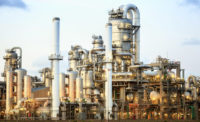Pulp and paper mills rely on functioning, quality refractory to keep the plant up and running. These operations’ worst nightmare is unplanned downtime and maintenance. One singular shutdown can cost mills thousands of dollars a day in lost production, especially for a facility that is producing more than three hundred thousand tons of pulp and paper per year.
One mill in Terrace Bay, Ontario, faced a refractory failure just one year after a fresh installation. The mill had an assessment completed which identified the problem as poor installation and inferior bricks. To combat this, the pulp and paper mill reached out to a man known for his quality bricking installations: John Taylor, founder and president of Kingston Refractory Services (KRS). Taylor and his team knew they needed to do the job right. And the best way to do that is to use the most effective equipment, which is why they rented, and ultimately purchased, a bricking machine from Bricking Solutions.
Contracting excellence
When looking for a new contractor to install refractory brick, the pulp and paper mill knew it needed someone who’s been in the business for a long time with a reputation for quality work. Taylor was just the man. He worked as a brick layer with the brick layer’s union out of Kingston before starting his own company. When he had the opportunity to do a refractory brick installation for a large cement facility in 2008, he and his wife, Laurie, worked together to start their own company: Kingston Refractory Services (KRS).
KRS provides refractory engineering, demolition, installation, clean up, anchor removal and more. They primarily service the Southern Ontario region of Canada with a few customers in Northern Ontario. Most of the facilities they work with own their own custom bricking machines for refractory installation. This is where Taylor and his team were first introduced to Bricking Solutions, which left an impression on a man who is known for his commitment to his team’s safety.
Andrew Wojciechowski, director of operations for Kingston Refractory Service’s subsidiary branch, Réfractaire Québec, explained, “John is adamant about safety in the field. It is the No. 1 priority for us and always has been. KRS is going on six years without any kind of safety-related incident. We’ve even stopped working before when an installation became unsafe just to reassess our methods.”
Taylor found that bricking machines provided the safest and highest performing installations in the business. For the first installation with the pulp and paper plant, he decided to rent a Bricking Solutions EZ Flexx50 bricking machine.
The safest choice
The first step of the pulp and paper plant installation came in a single kiln rebricking. Taylor and his crew decided to rent a bricking machine for the process. The EZ Flexx50 bricking machine is capable of bricking 9.8- to 13-foot (3 to 4 m) interior diameter kilns and has a 6,600-pound (3,000 kg) load capacity with a 12-foot (3.65 m) work platform. Made of 6061-T6 aircraft-grade aluminum, the structure is as strong as steel but weighs two-thirds less. Their crew can install the bricking machine in just 60 to 90 minutes whereas other methods take between 6 to 8 hours to set up.
The previous installation used the pogo stick method, one of the oldest systems for bricking installation. This method suites all brick shapes, but, unfortunately, setup time can take as long as a day in larger kilns. It uses a fabricated wooden arch that sits on a platform and uses spring loaded rods — pogo sticks — to push the bricks against the kiln shell to hold them in place. This approach limits installers to just one course at a time to ensure the jig doesn’t collapse. Because one pogo stick is required for each brick, and must be individually set and retracted, installation time is extended. There also isn’t a standard platform available to facilitate the bricking procedure and no international design or safety standards.
This installation method is also very hard on the body of the crew because it requires a lot of above-height work. Workers are required to set up each individual pogo stick and hold the bricking in place as they go, risking worker fatigue. A group of skilled workers using a bricking machine can complete a project twice as quickly as they could with another method. The pneumatic ring of the bricking machine holds the bricks against the shell of the kiln instead of relying on crew members to do so manually.
The most challenging feature of the kiln in the pulp and paper plant came in the dual layer installation. This type of installation requires two layers of brick, first a layer of insulation brick mortared together and, second, a layer of hot face brick. The bricking machine significantly improved the efficiency of the installation team because the arch could easily be adjusted to fit the second ring of brick instead of requiring a changeout of pogo sticks like the previous method required. The bricking machine’s arches hold each brick firmly against the kiln shell to reduce the risk of sagging. This properly aligns the brickwork and fights against catastrophic failure, which is what the pulp and paper plant experienced with the last installation.
“Both the plant and our team were extremely satisfied with the result of the project with the use of the Bricking Solutions bricking machine,” Wojciechowski said. “Being able to use the bricking machine for the plant allowed the customer to see the technology and experience the results in real-time.”
Partners for the long term
The increased efficiency of the bricking machine alongside the extended lifespan of the refractory brick impressed the pulp and paper plant so much that they invited KRS back to do a full shutdown at the facility. To complete the shutdown, KRS decided to purchase an EZ Flexx50 bricking machine of their own. It gave them the opportunity to complete the rebricking of the pulp and paper plant and offer more options to clients who may not own their own machine.
John Taylor and the KRS team always want to build a partnership with their clients for the long-term. The full rebricking job was completed ahead of time and under budget with the use of the newly purchased Bricking Solutions bricking machine. The plant was extremely satisfied with the results of the installation and the quality of the refractory brick lining, especially when they found that the refractory lifespan was stretched to an impressive three years. The pulp and paper plant reached out to KRS to work with them for the next refractory installation project that they’ll be completing soon.



